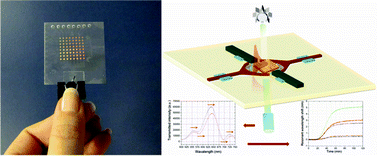 As featured on the bright inside front cover of Issue 5, this HOT article from Teodor Veres and colleagues at the National Research Council and McGill University, Canada, steps towards low cost point-of-care sensors for disease diagnosis.
As featured on the bright inside front cover of Issue 5, this HOT article from Teodor Veres and colleagues at the National Research Council and McGill University, Canada, steps towards low cost point-of-care sensors for disease diagnosis.
The team present their all-polymeric nanoplasmonic microfluidic (NMF) transmission surface plasmon resonance (SPR) biosensor. SPR, involving light stimulated electron oscillation, is advantageous for sensing as it means label-free, real-time detection with high throughput and automation. The device is miniaturised with a view to small, point-of-care applications. The approach involves nanostructures called nanogratings for transmission SPR, which gives a more stable response. The signal can be turned by altering their characteristics and they are easily fabricated en mass.
Thermoplastic materials present an advantage over traditional PDMS for such miniaturised SPR devices as they are more mechanically robust, inert, transparent and crucially viable for large scale production and commercial applications. The novel aspect of this work is that the nanostructured surface and the microchannels are incorporated into one substrate quickly and at low cost. Thermoplastic valves are used in large numbers for the first time for a multiplex detection scheme.
They demonstrate its application in sensing glycoprotein sCD44 at picomolar to nanomolar concentrations. Further work by the group is focused on integrating this device with a CCD spectrometer.
See the design and performance results in the full paper, now available free for 4 weeks*:
All-thermoplastic nanoplasmonic microfluidic device for transmission SPR biosensing
Lidija Malic, Keith Morton, Liviu Clime and Teodor Veres
DOI: 10.1039/C2LC41123G










